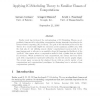Free Online Productivity Tools
i2Speak
i2Symbol
i2OCR
iTex2Img
iWeb2Print
iWeb2Shot
i2Type
iPdf2Split
iPdf2Merge
i2Bopomofo
i2Arabic
i2Style
i2Image
i2PDF
iLatex2Rtf
Sci2ools
IPPS
2007
IEEE
2007
IEEE
Applying IC-Scheduling Theory to Familiar Classes of Computations
Earlier work has developed the underpinnings of IC-Scheduling Theory, an algorithmic framework for scheduling computations having intertask dependencies for Internet-based computing (IC, for short). The goal of the schedules produced by the Theory is to render tasks eligible for execution at the maximum possible rate, with the dual aim of: (a) utilizing remote clients’ computational resources well, by always having work to allocate to an available client; (b) lessening the likelihood of the “gridlock” that ensues when a computation stalls for lack of tasks that are eligible for execution. While motivated by real computations, the Theory has been develh computations represented abstractly, via directed acyclic graphs (dags). ent paper reconnects the abstract theory with an eclectic variety of real computations and computational paradigms, by illustrating how to schedule these computations optimally.
Computations | Computations Having Intertask | Distributed And Parallel Computing | IPPS 2007 | Real Computations |
Related Content
| Added | 03 Jun 2010 |
| Updated | 03 Jun 2010 |
| Type | Conference |
| Year | 2007 |
| Where | IPPS |
| Authors | Gennaro Cordasco, Grzegorz Malewicz, Arnold L. Rosenberg |
Comments (0)

